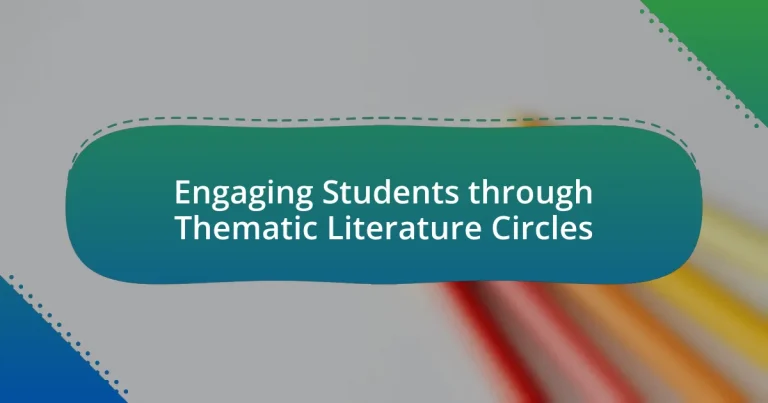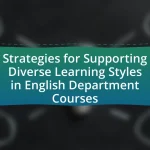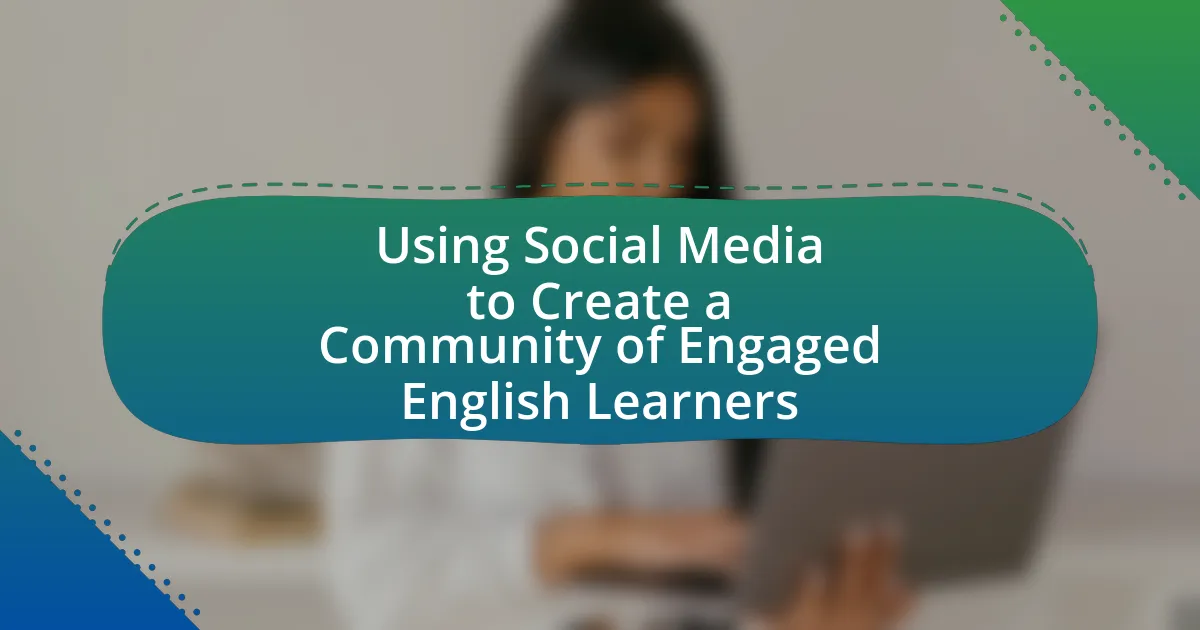Thematic Literature Circles are collaborative learning structures that engage students in reading and discussing literature centered around specific themes. This approach enhances critical thinking, comprehension, and student motivation by allowing for choice in reading selections and promoting active participation. Key elements include student choice, collaborative discussion, thematic focus, and varied roles, all of which foster a sense of community and encourage diverse perspectives. The article explores how educators can effectively implement these circles, the skills students develop through participation, and strategies to address common challenges, ultimately highlighting the importance of thematic literature circles in education.

What are Thematic Literature Circles?
Thematic Literature Circles are collaborative learning structures where students engage with texts centered around a specific theme. In these circles, participants read and discuss literature that shares common thematic elements, allowing for deeper exploration of ideas and connections among different works. Research indicates that this approach enhances critical thinking and comprehension skills, as students actively participate in discussions, share insights, and reflect on their readings. Thematic Literature Circles foster a sense of community and encourage diverse perspectives, making literature more relatable and engaging for students.
How do Thematic Literature Circles engage students?
Thematic Literature Circles engage students by fostering collaborative learning and promoting critical thinking. In these circles, students discuss literature centered around a common theme, which encourages them to share diverse perspectives and deepen their understanding of the material. Research indicates that this method enhances student motivation and engagement, as it allows for choice in reading selections and promotes active participation. A study by Daniels and Steineke (2017) highlights that students involved in Literature Circles demonstrate improved comprehension and retention of content, as they are more invested in discussions that relate to their interests and experiences.
What are the key elements of Thematic Literature Circles?
The key elements of Thematic Literature Circles include student choice, collaborative discussion, thematic focus, and varied roles. Student choice allows participants to select texts that resonate with their interests, fostering engagement. Collaborative discussion encourages peer interaction, enhancing comprehension through shared insights. The thematic focus ensures that all texts relate to a central idea, promoting deeper exploration of concepts. Varied roles, such as discussion leader or summarizer, provide structure and accountability, facilitating active participation. These elements collectively create an interactive learning environment that enhances literary understanding and critical thinking skills.
How do themes enhance student engagement in literature circles?
Themes enhance student engagement in literature circles by providing relatable and thought-provoking contexts that stimulate discussion and critical thinking. When students connect with themes, such as identity, conflict, or social justice, they are more likely to invest emotionally and intellectually in the material. Research indicates that thematic discussions encourage deeper comprehension and personal connections to the text, fostering a collaborative learning environment. For instance, a study by Beers and Probst (2013) highlights that students who engage with thematic content demonstrate increased motivation and participation, as they feel their perspectives are valued and relevant to the conversation.
Why are Thematic Literature Circles important in education?
Thematic Literature Circles are important in education because they promote active engagement and critical thinking among students. These circles facilitate collaborative learning, allowing students to explore themes deeply through discussion and shared perspectives. Research indicates that such collaborative environments enhance comprehension and retention of material, as students are more likely to engage with texts when they can relate them to their own experiences and viewpoints. Additionally, studies show that students involved in literature circles demonstrate improved communication skills and a greater appreciation for diverse literary voices, which are essential competencies in today’s multicultural society.
What skills do students develop through participation in literature circles?
Students develop critical thinking, communication, collaboration, and analytical skills through participation in literature circles. Critical thinking is enhanced as students analyze texts and discuss various interpretations, fostering deeper comprehension. Communication skills improve as students articulate their thoughts and engage in discussions, learning to express ideas clearly and respectfully. Collaboration is cultivated through group interactions, where students must work together to explore themes and share insights. Additionally, analytical skills are sharpened as students evaluate characters, plot developments, and thematic elements, leading to a more nuanced understanding of literature. Research indicates that these skills are essential for academic success and personal development, as highlighted in studies on cooperative learning and peer discussions in educational settings.
How do Thematic Literature Circles promote critical thinking?
Thematic Literature Circles promote critical thinking by encouraging students to engage deeply with texts through discussion and collaboration. In these circles, students analyze themes, characters, and contexts, which fosters a deeper understanding of the material. Research indicates that collaborative learning environments, such as those created in Literature Circles, enhance critical thinking skills by requiring students to articulate their thoughts, challenge each other’s perspectives, and synthesize information from various sources. This active engagement not only improves comprehension but also cultivates analytical skills essential for critical thinking.

How can educators implement Thematic Literature Circles effectively?
Educators can implement Thematic Literature Circles effectively by organizing students into small groups based on shared interests in specific themes, allowing them to select texts that align with those themes. This approach fosters engagement and promotes deeper discussions, as students are more invested in the material. Research indicates that when students choose their reading materials, their motivation and comprehension improve significantly, as highlighted in a study by Daniels (2002) in “Literature Circles: Voice and Choice in Book Clubs and Reading Groups.” Additionally, educators should provide structured roles within each group, such as discussion leader or summarizer, to ensure that all students participate actively and contribute to the conversation. This method not only enhances collaborative learning but also develops critical thinking skills, as students analyze and interpret texts through diverse perspectives.
What steps should teachers take to set up Thematic Literature Circles?
To set up Thematic Literature Circles, teachers should first select a central theme that aligns with the curriculum and student interests. Next, they should choose a variety of texts that reflect this theme, ensuring diverse perspectives and genres. After selecting the texts, teachers must group students based on their reading levels and interests, allowing for balanced discussions. Teachers should then establish roles for each student within the circles, such as discussion leader, summarizer, or connector, to facilitate engagement and accountability. Finally, teachers should create a schedule for reading and discussion, providing guidelines for each session to ensure productive conversations. These steps are supported by research indicating that structured group discussions enhance comprehension and critical thinking skills among students.
How do teachers select appropriate themes and texts?
Teachers select appropriate themes and texts by aligning them with curriculum standards, student interests, and developmental levels. They analyze educational objectives to ensure that the chosen themes foster critical thinking and engagement. For instance, research indicates that texts reflecting diverse perspectives enhance student empathy and understanding, making them more relevant in a multicultural classroom. Additionally, teachers often utilize student feedback and assessments to refine their selections, ensuring that the materials resonate with learners and promote active participation in thematic literature circles.
What roles can students take on within literature circles?
Students can take on various roles within literature circles, including discussion director, summarizer, connector, vocabulary enricher, and illustrator. Each role has specific responsibilities that enhance comprehension and engagement. For instance, the discussion director facilitates conversations by preparing questions, while the summarizer captures key points of the text. The connector relates themes to personal experiences or current events, the vocabulary enricher identifies and explains challenging words, and the illustrator creates visual representations of the text. These roles promote collaborative learning and critical thinking, making literature circles an effective educational strategy.
What strategies can enhance the effectiveness of Thematic Literature Circles?
To enhance the effectiveness of Thematic Literature Circles, implementing structured roles for participants significantly improves engagement and accountability. Assigning specific roles, such as discussion leader, summarizer, or connector, encourages active participation and ensures that all students contribute to the conversation. Research indicates that when students take on defined responsibilities, they are more likely to engage deeply with the text and with each other, fostering a collaborative learning environment. Additionally, integrating diverse texts that reflect various perspectives within the theme can stimulate richer discussions and critical thinking, as students draw connections between their readings and real-world contexts. This approach not only enhances comprehension but also promotes empathy and understanding among peers.
How can teachers facilitate discussions among students?
Teachers can facilitate discussions among students by creating a structured environment that encourages open dialogue and critical thinking. They can implement strategies such as establishing clear discussion guidelines, using open-ended questions to stimulate conversation, and assigning specific roles to students during discussions to ensure participation. Research indicates that structured discussions enhance student engagement and comprehension, as evidenced by a study published in the Journal of Educational Psychology, which found that students who participated in guided discussions demonstrated improved analytical skills and deeper understanding of the material.
What assessment methods can be used to evaluate student participation?
Assessment methods to evaluate student participation include observation, self-assessment, peer assessment, and participation rubrics. Observation allows educators to monitor student engagement and contributions during discussions, providing real-time insights into participation levels. Self-assessment encourages students to reflect on their own involvement and set personal goals for improvement. Peer assessment fosters collaborative evaluation, where students assess each other’s contributions, promoting accountability. Participation rubrics offer clear criteria for evaluating engagement, ensuring consistency and transparency in assessment. These methods collectively provide a comprehensive approach to measuring student participation in thematic literature circles.

What challenges might educators face with Thematic Literature Circles?
Educators may face several challenges with Thematic Literature Circles, including varying student engagement levels, difficulty in group dynamics, and the need for extensive preparation. Varying engagement levels can lead to unequal participation, where some students dominate discussions while others remain passive. Additionally, group dynamics may pose issues, as differing opinions and personalities can create conflict or hinder collaboration. Finally, educators often require significant preparation to select appropriate texts and design effective discussion prompts that align with the themes, which can be time-consuming and complex.
How can teachers address common obstacles in implementing literature circles?
Teachers can address common obstacles in implementing literature circles by providing structured guidelines and clear expectations for student participation. Establishing roles within the literature circles, such as discussion leader or summarizer, helps students understand their responsibilities and encourages accountability. Research indicates that when students have defined roles, they are more likely to engage meaningfully with the text and each other, enhancing comprehension and collaboration. Additionally, offering professional development for teachers on facilitating literature circles can equip them with strategies to manage diverse reading levels and foster inclusive discussions, ultimately leading to a more effective implementation of this instructional strategy.
What strategies can help manage diverse reading levels in a group?
To manage diverse reading levels in a group, differentiated instruction is essential. This strategy involves tailoring reading materials and activities to meet the varying abilities of students, ensuring that each learner is engaged and challenged appropriately. For instance, providing texts at multiple reading levels on the same theme allows all students to participate in discussions while accessing content suited to their skills. Research by Tomlinson (2001) emphasizes that differentiated instruction can lead to improved student engagement and comprehension, as it addresses individual learning needs effectively. Additionally, using flexible grouping strategies, such as pairing stronger readers with those who need support, fosters collaboration and peer learning, further enhancing the overall learning experience.
How can teachers encourage reluctant readers to participate?
Teachers can encourage reluctant readers to participate by incorporating thematic literature circles that align with students’ interests. This approach allows students to choose texts that resonate with them, fostering a sense of ownership and engagement. Research shows that when students are involved in selecting reading materials, their motivation increases significantly, leading to higher participation rates. For instance, a study by Gambrell et al. (2007) found that student choice in reading resulted in improved attitudes toward reading and greater engagement in discussions. By creating a supportive environment where students can share their thoughts and connect with peers, teachers can further enhance participation among reluctant readers.
What are best practices for sustaining student engagement in Thematic Literature Circles?
Best practices for sustaining student engagement in Thematic Literature Circles include fostering a collaborative environment, allowing student choice in reading materials, and integrating diverse multimedia resources. Collaborative environments encourage peer interaction and discussion, which enhances understanding and retention of themes. Research indicates that when students have the autonomy to select texts that resonate with their interests, their motivation and engagement levels increase significantly. Additionally, incorporating multimedia resources, such as videos and podcasts related to the themes, caters to various learning styles and keeps the content dynamic. These strategies collectively create an engaging and enriching experience for students in literature circles.
How can ongoing feedback improve the literature circle experience?
Ongoing feedback can significantly enhance the literature circle experience by fostering a collaborative learning environment. This continuous exchange of insights allows participants to refine their understanding of the text, clarify misconceptions, and deepen their analytical skills. Research indicates that feedback promotes engagement and motivation among students, as it encourages them to take ownership of their learning process. For instance, a study by Hattie and Timperley (2007) highlights that effective feedback can lead to a 30% increase in student performance, demonstrating its critical role in educational settings. Thus, ongoing feedback not only improves comprehension but also cultivates a sense of community and accountability within literature circles.
What role does student choice play in maintaining interest?
Student choice plays a crucial role in maintaining interest by fostering intrinsic motivation among learners. When students have the autonomy to select topics or texts that resonate with their personal interests, they are more likely to engage deeply with the material. Research indicates that autonomy in learning environments enhances student engagement and motivation, as evidenced by a study published in the Journal of Educational Psychology, which found that students who exercised choice in their reading selections demonstrated higher levels of interest and comprehension. This connection between choice and engagement underscores the importance of incorporating student preferences in educational settings, particularly in thematic literature circles, where personalized learning experiences can significantly enhance student involvement and enthusiasm.
What practical tips can educators use to maximize the benefits of Thematic Literature Circles?
Educators can maximize the benefits of Thematic Literature Circles by implementing structured roles for students, fostering collaborative discussions, and selecting diverse texts that align with the themes. Assigning specific roles, such as discussion leader or summarizer, encourages accountability and engagement among participants. Collaborative discussions enhance critical thinking and allow students to explore different perspectives, which is supported by research indicating that peer interaction improves comprehension and retention. Additionally, choosing a variety of texts that reflect multiple viewpoints within a theme ensures that all students can connect personally to the material, thereby increasing motivation and interest in the literature.




